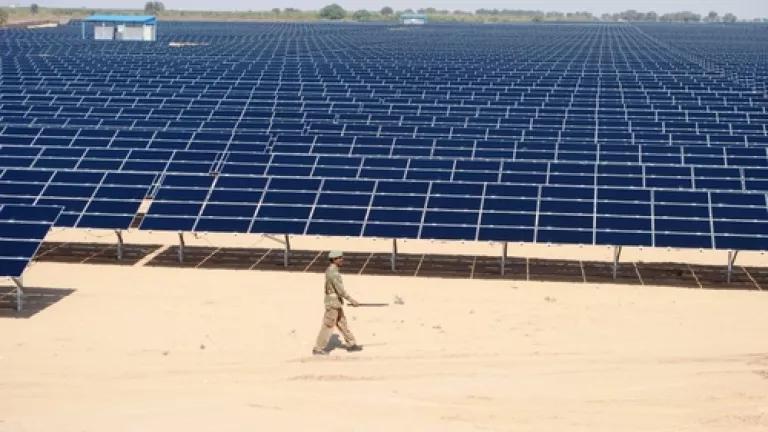
Co-authored by Nehmat Kaur and Meredith Connolly of NRDC’s India Initiative
These are exciting times for India’s solar market. The solar resource-rich country just crossed the 3 gigawatt mark for total installed solar capacity. The Indian Renewable Energy Development Agency (IREDA) and the United States Export-Import Bank (US EX-IM) just signed an MOU for cooperation on clean energy investments, solidifying the US EX-IM’s $1 Billion line of credit to IREDA. In parallel with these announced developments, India’s Ministry of New & Renewable Energy (MNRE) together with the US Department of Energy (DOE), and the National Renewable Energy Laboratory (NREL), organized a workshop series on “Solar Resource Assessment and Solar Project Development” to build on the ongoing renewable energy collaboration as part of the US – India Energy Dialogue.
The series of three workshops were designed to provide solar developers throughout India with information on new solar resource data tools and training on how to leverage data in financial analyses to improve assessments of potential solar projects. At the third and final workshop in Gurgaon at the end of November, our NRDC team presented our recently released findings and analyses on India’s renewable energy financing needs and job creation potential.
The spotlight on renewables and solar financing in India becomes even more timely with MNRE’s recent announcement of a dramatically increased target of 100 gigawatt (GW) of solar installed capacity by 2022. Securing affordable financing is imperative if India is to achieve this ambitious target. The latest research by NRDC and our partner, the Council on Energy, Environment and Water (CEEW), shows that domestic banks and non-banking financial companies have a big role to play in supporting the solar market.
Financing Perceived Risks and Barriers:
It is well known that domestic banks were conspicuously absent during Phase I of India’s National Solar Mission (NSM). Developers relied mostly on multilateral funding as well as self-financing to set up projects during the first phase. Despite some involvement of domestic banks in both Phase I as well as batch I of Phase II (allotted in February 2014), banks still perceive significant risks and face some barriers in lending to solar projects.
Financing decisions have in the past, and continue to be, dependent on assessment of technical risks such as lack of irradiance and project performance data. On the policy front, frequent changes in policy and structures for incentives, PPA signing counterparties and timelines all result in uncertainty that dissuade bankers from betting on solar. Additional risk factors like grid compatibility of solar and India’s economic conditions discouraged bankers from financing solar.
Kiran Energy’s 20 MW Solar Plant in Jodhpur, Rajasthan, India. © Kiran Energy
Financing Opportunities and Recommendations:
Although these notable risks have impacted solar developers’ ability to secure affordable finance for their projects in India – with higher interest rates and shorter-term loans being commonplace – financing solutions also exist.
While not currently deployed for utility-scale solar in India, mechanisms such as priority sector lending and infrastructure debt funds (IDFs) are examples of programs that could increase funding and lower capital costs. International leading solar markets such as China, United States and Brazil all offer key insights into financial models that can be adopted to address India’s challenges. China’s renewable energy legal framework, priority dispatch and dedicated renewable energy development fund have done exceeding well in deploying solar installed capacity. The United States has successfully utilized green bonds and green banks for financing solar.
Continued policy innovation and new financial mechanisms are needed in India to lower the persistently high cost of capital and increase the flow of capital, thereby scaling solar installations at a rapid pace. Our analysis of India’s solar market and financing opportunities has resulted in the following recommendations, as presented at the Gurgaon workshop:
Enforce Renewable Portfolio Obligations (RPOs) to create demand for solar: On the policy side, RPOs are a significant missed opportunity. Weak compliance has failed to create the demand that would otherwise exist. Enforcing RPOs is a policy priority.
Use green bonds, priority sector lending and IDFs for greater capital flow: Some financial mechanisms that have been successful internationally will become more viable as the market matures. Green bonds and IDFs can act as conduits for debt to flow into solar projects at more favorable terms. Such mechanisms have been explored in a limited way for the market in India thus far. IREDA issued a 15-year (long-term) tax-free bond to fund solar projects earlier this year. With respect to priority sector lending, including utility scale solar as a priority sector that mandates investment from domestic banks would allow them to lend to solar without funds being crowded out due to banks’ sectoral lending caps.
Establish a dedicated green bank within an existing institution: Green banks for financing renewables with low cost, long-term financing have been implemented successfully internationally. Establishing a new institution of such scope will of course be challenging and further assessment is required to understand the feasibility of such an initiative in the Indian context. Our analysis shows an existing institution could be developed into a dedicated green bank as well.
Additionally, learning from state policy incentives, ensuring timely program implementation and increasing transparency in the market will all ultimately have a significant positive impact on increasing market and investor confidence and increase the flow of funding at lower interest rates. All of these financing mechanisms and policy interventions could help unleash solar power installations across the country, enabling solar resource-rich India to reach its potential and become an international solar leader.
NRDC and CEEW are currently exploring the feasibility of some of these specific recommendations based on our analysis for implementation in India. More information and access to our fact sheets and reports on the topic are available here: Employment Potential and Financing Solutions for Solar and Wind Energy.
